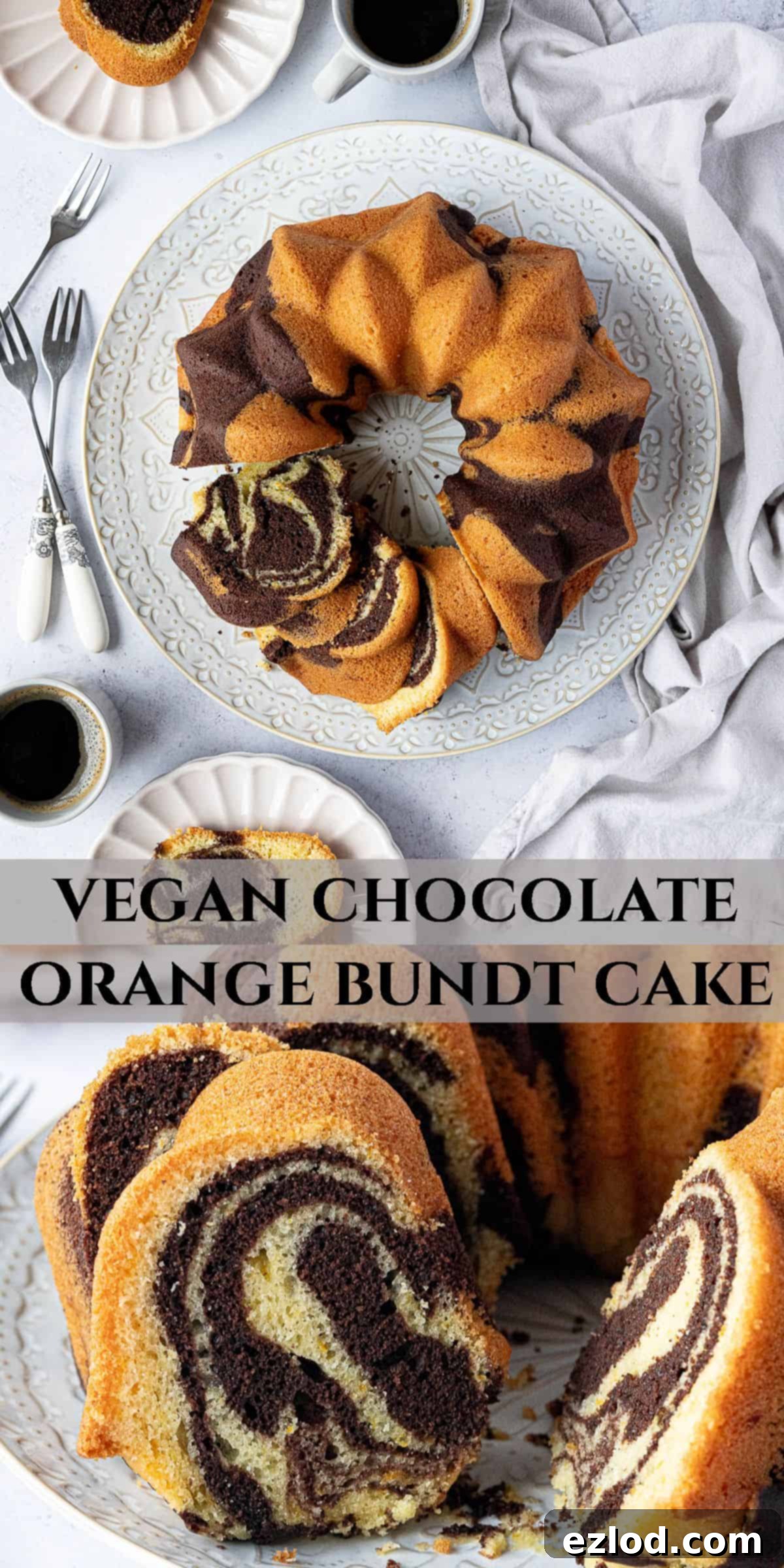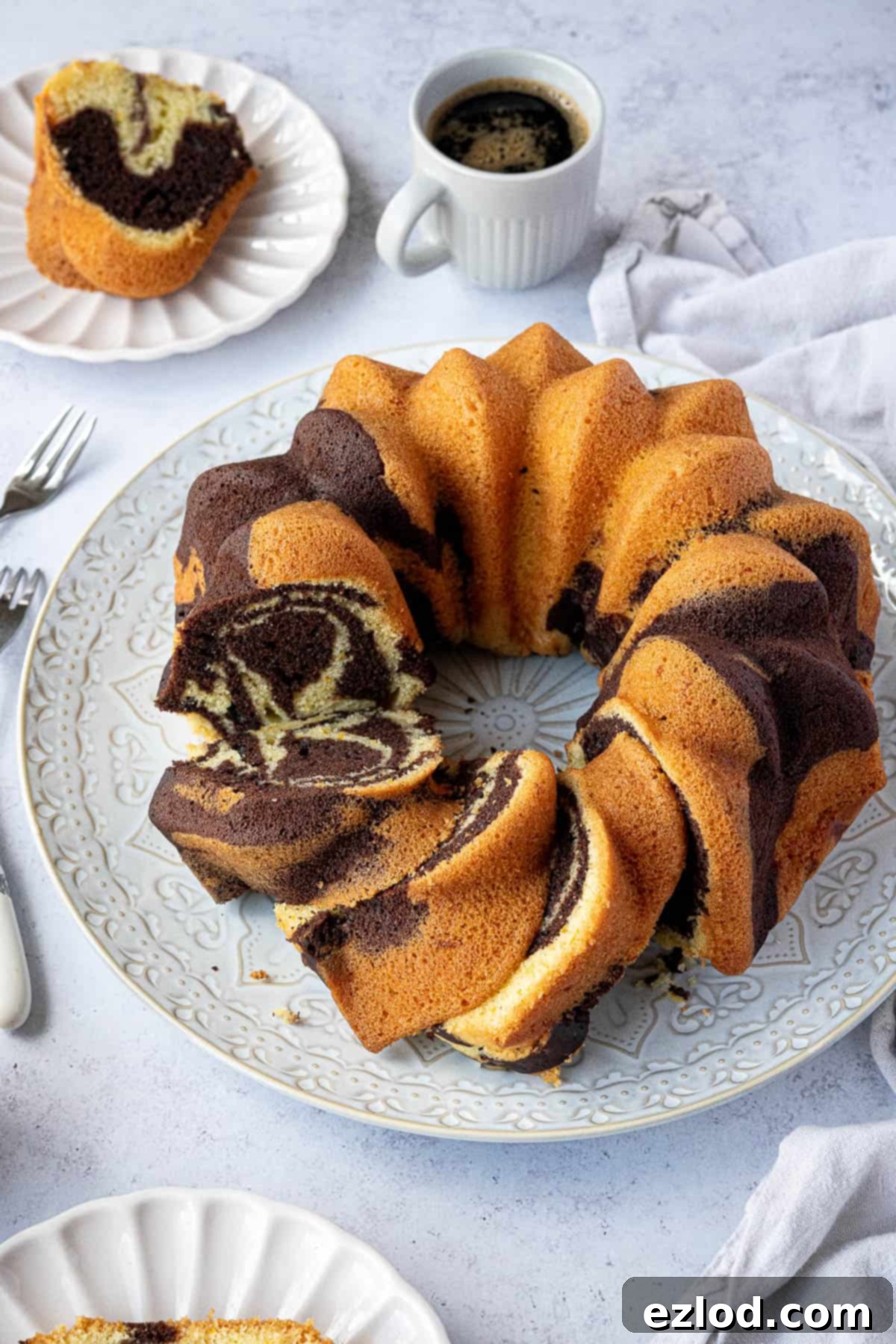Irresistible Vegan Chocolate Orange Bundt Cake: Your New Favorite Easy Recipe
Indulge in the delightful harmony of rich chocolate and vibrant orange with this incredibly soft, moist, and utterly delicious vegan bundt cake. Not only is it a treat for your taste buds, but it’s also remarkably budget-friendly and surprisingly simple to whip up, making it the perfect dessert for any occasion. Whether you’re a seasoned baker or just starting your plant-based journey, this recipe promises a stunning outcome with minimal fuss.

This chocolate orange bundt cake stands out for its extraordinary softness and moisture, a testament to its unique formulation. Crafted using a handful of readily available, basic ingredients, it’s an economical choice that doesn’t compromise on flavor or texture. Its inherent simplicity makes it an approachable recipe for anyone looking to bake a truly impressive dessert without a complex ingredient list or an overwhelming process.
The inspiration for this delightful creation comes from the traditional Italian ciambellone all’acqua, a beloved cake renowned for its dairy-free nature. This traditional “water donut” cake, often baked in a ring or bundt tin, characteristically relies on water and oil, sometimes with eggs, sometimes without. Our version cleverly adapts the eggless rendition, which, by happy accident, is entirely vegan! This makes it a fantastic option for those with dietary restrictions or anyone looking to explore plant-based baking. The ciambellone’s versatility shines through as it can be infused with various flavors, and our marbled chocolate orange adaptation is a prime example of its potential – simple in concept, yet profoundly satisfying in taste.
The beauty of this bundt cake lies in its beautiful marbled appearance, created by swirling two distinct batters together. The vibrant orange batter, bursting with citrusy notes, perfectly complements the deep, rich chocolate batter. Each slice reveals a stunning pattern, making it a showstopper at any table. Beyond its visual appeal, the cake’s texture is consistently tender and moist, ensuring a delightful eating experience from the first bite to the last. It’s more than just a cake; it’s a celebration of simple ingredients transformed into something truly special.
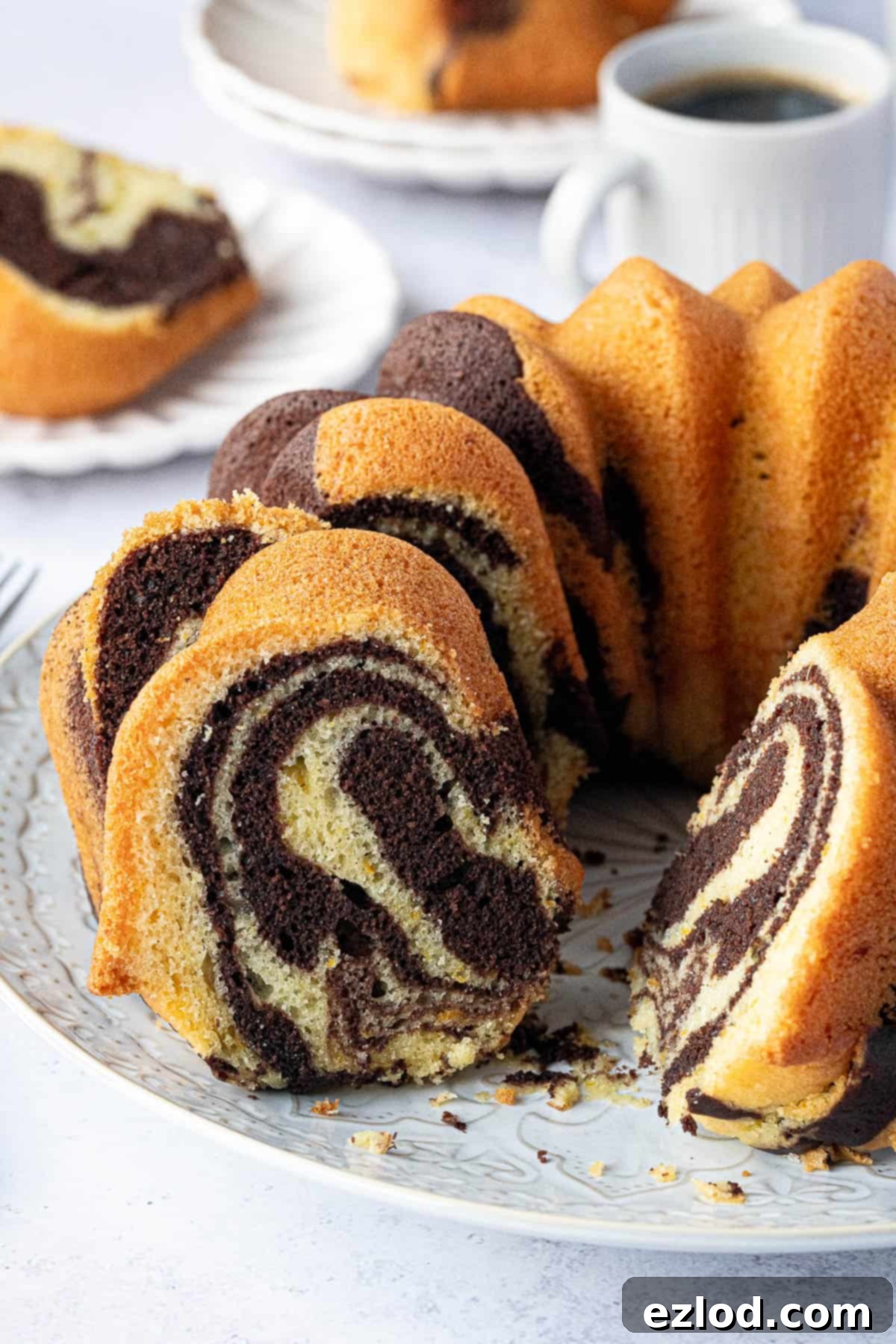
Essential Ingredients for Your Vegan Chocolate Orange Bundt Cake:
Crafting this exquisite bundt cake requires a few staple ingredients, most of which you likely already have in your pantry. Here’s a detailed look at what you’ll need and some tips for each:
Plain Flour (All-Purpose Flour): Standard plain (all-purpose) flour is ideal for this recipe. Its balanced protein content provides the perfect structure without making the cake tough. While I haven’t specifically tested a gluten-free version, a high-quality gluten-free all-purpose flour blend (one that contains xanthan gum) would likely work, though results may vary. If you opt for self-raising flour, you might need to adjust or omit the baking powder, depending on its leavening strength. Always check the label.
Baking Powder: This is a crucial leavening agent that gives the cake its wonderful rise and light, fluffy texture. It reacts with liquids and acids during baking to create air bubbles. It’s important to use baking powder, not bicarbonate of soda (baking soda), as they function differently in recipes. Ensure your baking powder is fresh for optimal results.
Sugar: Caster sugar is my preferred choice due to its fine texture, which dissolves easily and creates a smooth batter. However, granulated sugar works just as well. For a slightly different flavor profile, light brown soft sugar or coconut sugar can also be used, adding subtle caramel notes. Avoid liquid sugars like maple syrup or agave, or artificial sweeteners, as they can drastically alter the cake’s texture and moisture balance.
Oil: Any neutral-flavored vegetable oil is suitable. Sunflower oil, rapeseed oil, or a light olive oil are excellent choices. These oils contribute significantly to the cake’s moisture and tender crumb, especially in vegan baking where butter is omitted. Ensure the oil doesn’t have a strong flavor that might overpower the delicate chocolate and orange notes.
Orange: The star of the show! You’ll need both fresh orange zest and juice for the most vibrant flavor. The zest contains essential oils that provide an intense citrus aroma, while the juice adds moisture and tang. If fresh oranges aren’t available, carton orange juice can be used, but definitely try to get fresh zest if possible for that extra “zing.”
Cocoa Powder: I typically use Dutch-processed cocoa powder, which is darker and less acidic, resulting in a rich, mellow chocolate flavor. Natural cocoa powder can also be used, though it might produce a slightly lighter color and a more intense, sometimes slightly bitter, chocolate taste. Both will yield delicious results, so use what you have on hand.
Vinegar: This might seem like an unusual addition, but vinegar plays a vital role in the chocolate batter. It reacts with the baking powder, creating an extra lift and contributing to a light and fluffy texture. Since the orange batter already contains acidity from the orange juice, vinegar is only necessary for the chocolate portion. Any type of vinegar, such as cider vinegar or white vinegar, will work, as will fresh lemon juice as a substitute.
Water: The primary liquid in this cake is plain tap water. Its neutrality allows the other flavors to shine. However, for a richer cake, you can easily substitute the water with unsweetened plant milk, such as almond, soy, or oat milk, which is also mentioned in the variations section.
Flavor Extracts (Optional): To further enhance the flavor profile, I recommend adding a teaspoon of vanilla extract to the chocolate batter for warmth and depth, and a teaspoon of orange extract to the orange batter to intensify the citrus notes. While optional, these extracts elevate the overall taste experience considerably.
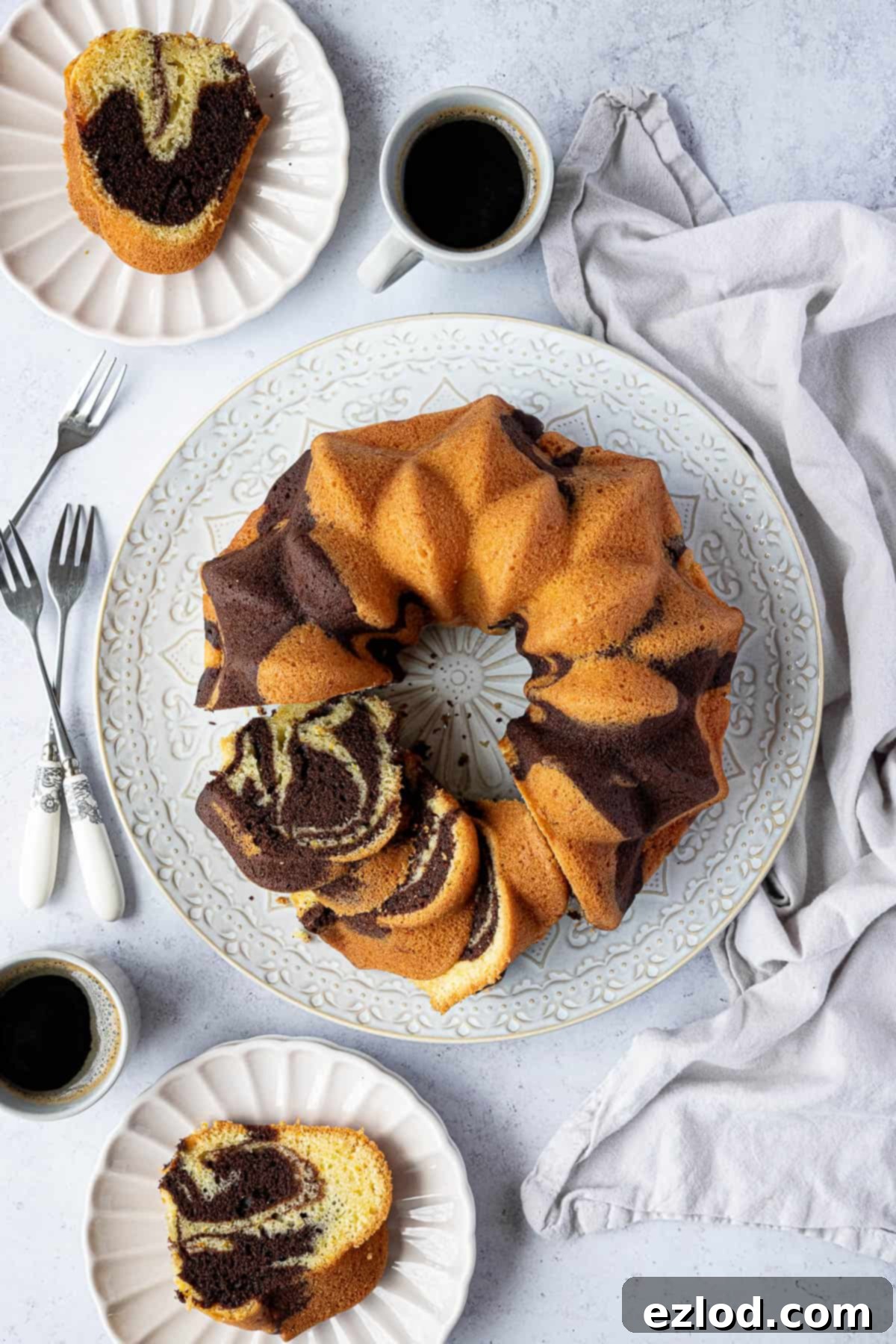
Baking Your Perfect Chocolate Orange Bundt Cake: A Step-by-Step Guide
(Full measurements and instructions can be found in the recipe card at the bottom of the page)
Baking this cake is a straightforward process, but paying attention to a few key steps will ensure a beautifully moist and tender result:
Preparation is Key: Begin by preheating your oven to the specified temperature (180°C/160°C fan/350°F/gas mark 4). The most critical step for any bundt cake is thoroughly greasing your tin. Use oil or melted vegan butter and, if desired, a light dusting of flour to ensure the cake releases cleanly. Pay extra attention to every nook and cranny of the bundt pan to prevent sticking.
Dry Ingredients: In two separate bowls, prepare your dry ingredients. Sift together the plain flour and baking powder for the orange batter in one bowl. In the second bowl, sift together the plain flour, baking powder, and cocoa powder for the chocolate batter. Sifting aerates the flour and helps prevent lumps, ensuring a smoother batter and a more even crumb.
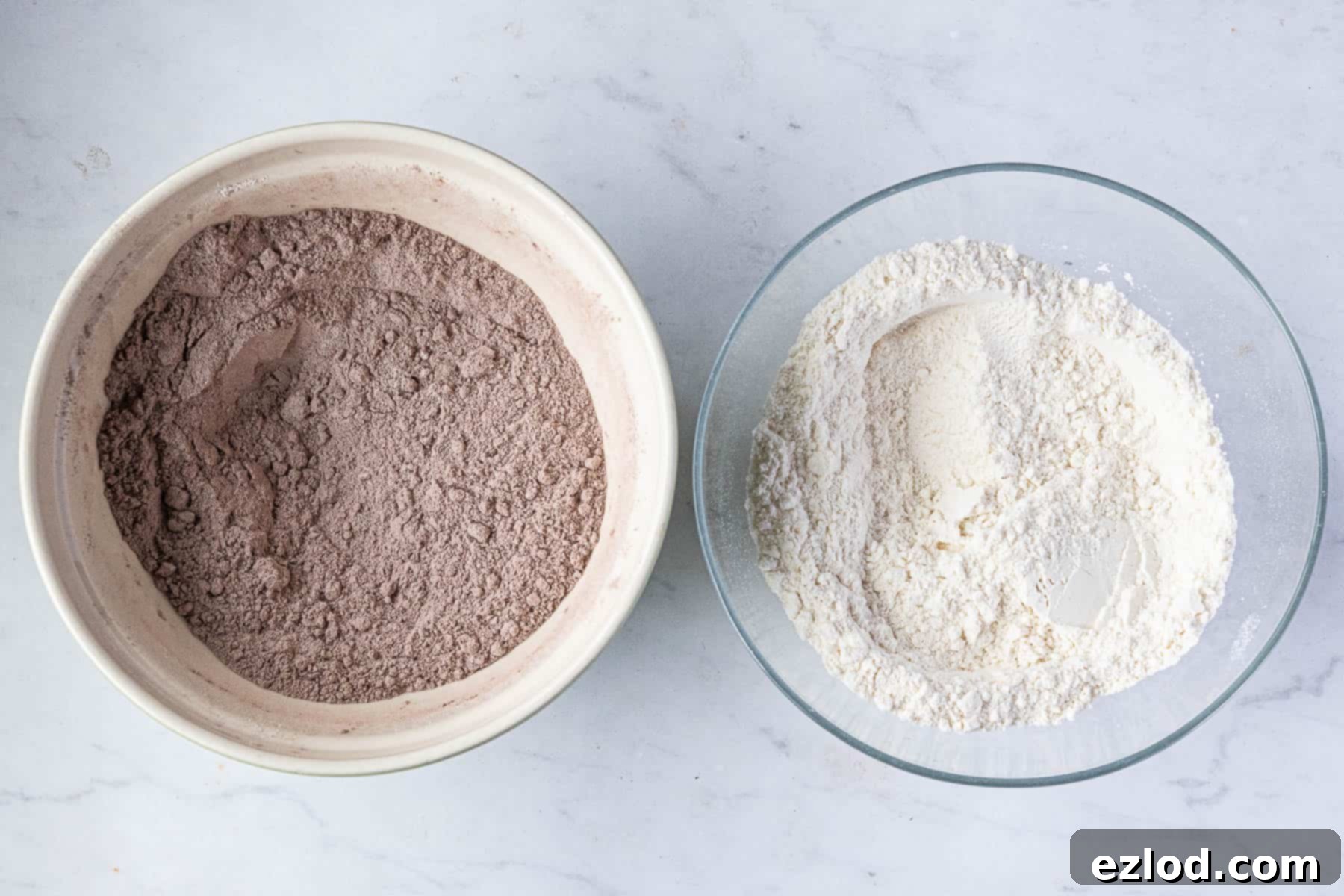
Wet Ingredients Integration: To the bowl with the orange batter dry ingredients, add the sugar, oil, orange zest, orange juice, and water, along with the optional orange extract. For the chocolate batter, combine the sugar, oil, vinegar, water, and optional vanilla extract with the dry ingredients.
Mixing the Batters: Using a balloon whisk, gently stir each batter until all dry lumps have disappeared. Be careful not to over-mix, as this can develop the gluten in the flour, leading to a tougher cake. Mix just until combined for a tender crumb.
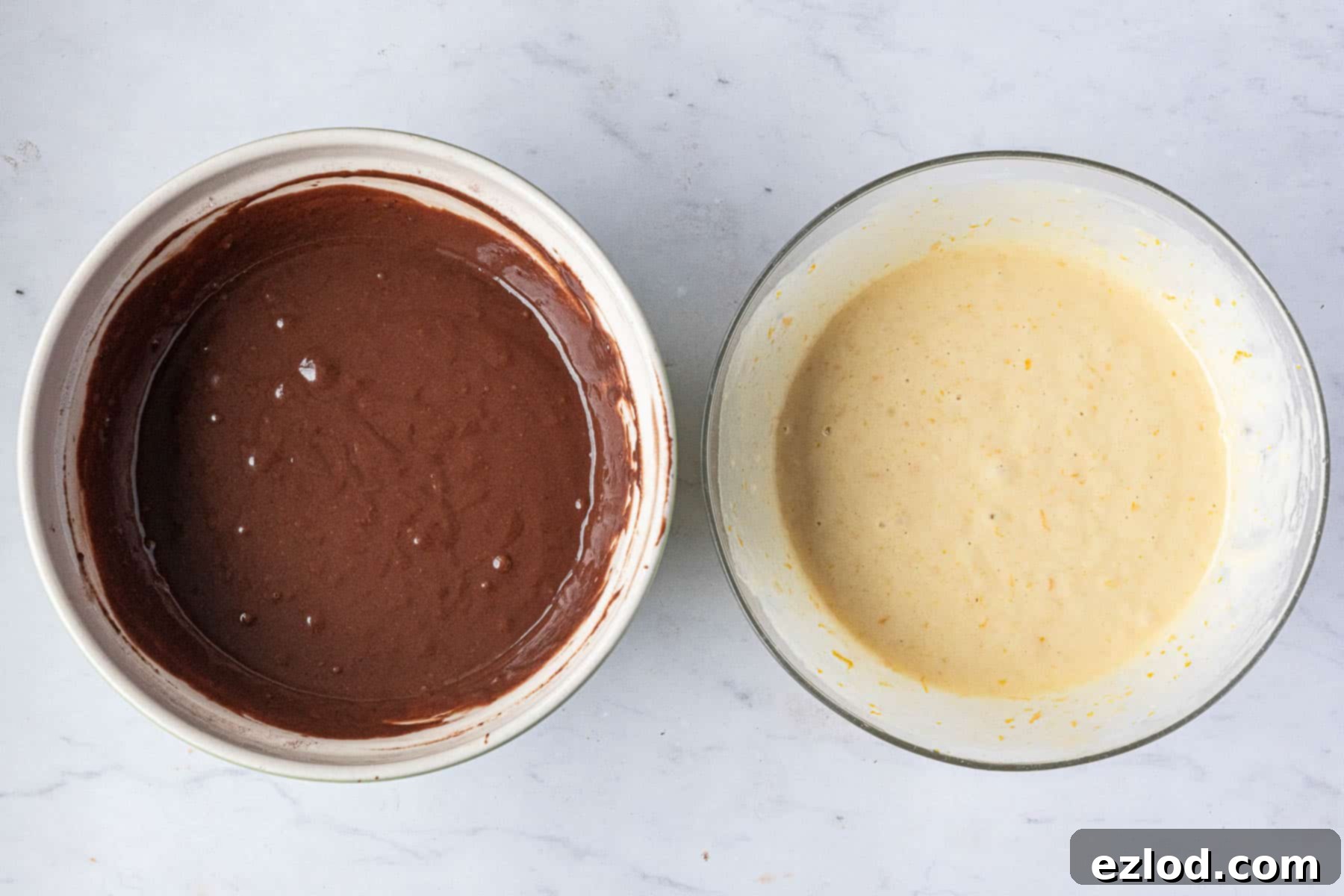
Creating the Marble Effect: Once your batters are ready, it’s time to create the beautiful marble swirl. Alternate spooning dollops of the orange and chocolate batters into your well-greased bundt tin. Don’t worry about perfection; the beauty is in the imperfection. Once all the batter is in, gently run a knife or a skewer through the batters a few times to create a lovely marbled pattern. Avoid over-swirling, as this can mix the colors too much.
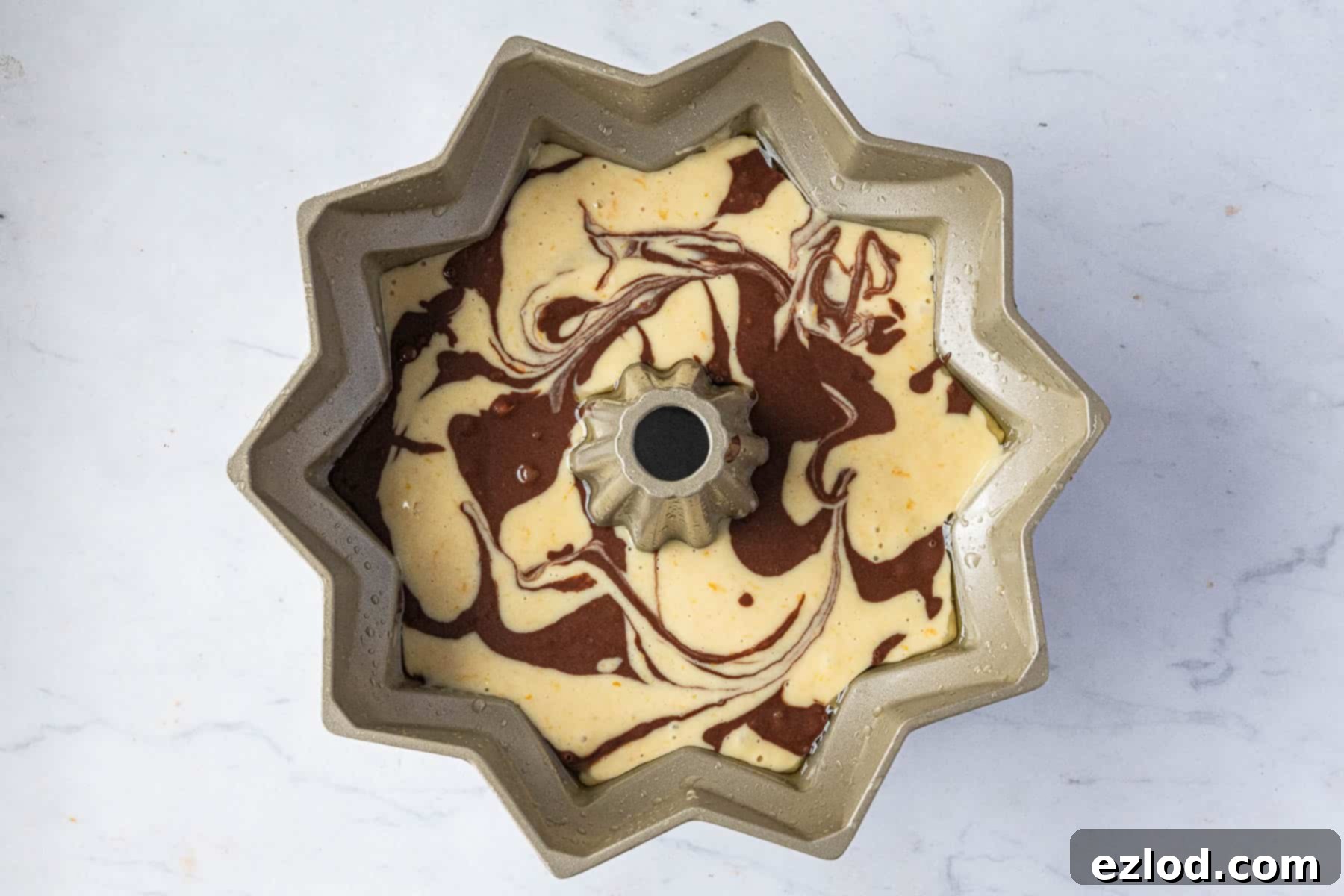
Baking: Place the bundt tin in your preheated oven and bake for 40-45 minutes. The exact baking time may vary slightly depending on your oven. The cake is ready when it looks golden, feels firm to the touch, and a skewer inserted into the thickest part comes out clean or with only a few moist crumbs attached.
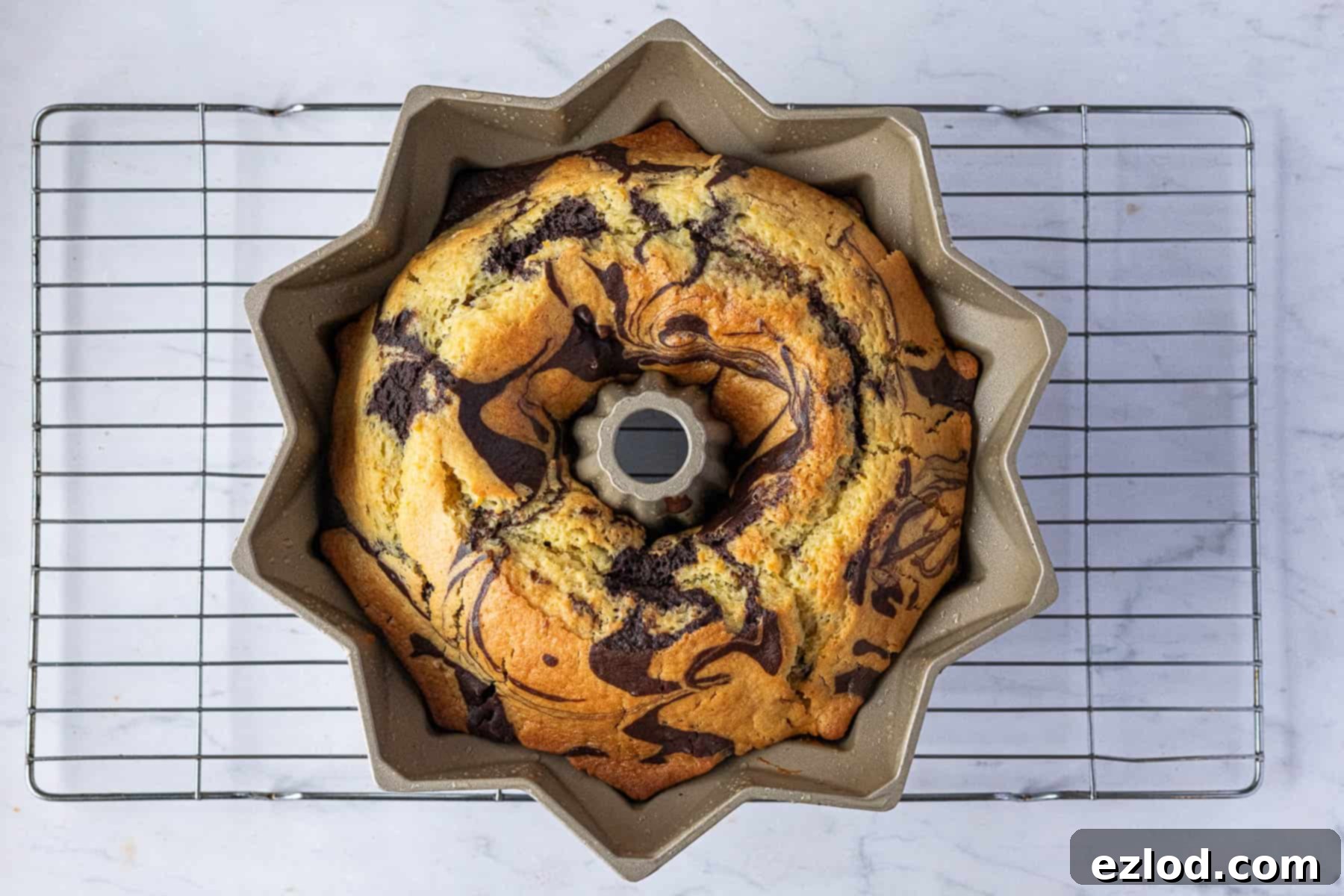
Cooling and Serving: After baking, it’s crucial to allow the cake to cool in the tin for about 20 minutes. Vegan cakes, in particular, tend to be more delicate than their non-vegan counterparts, and this cooling period allows the cake to set and firm up, preventing it from breaking when inverted. After 20 minutes, carefully turn the cake out onto a wire rack and let it cool completely before slicing and serving. This patience will be rewarded with a perfect bundt cake!
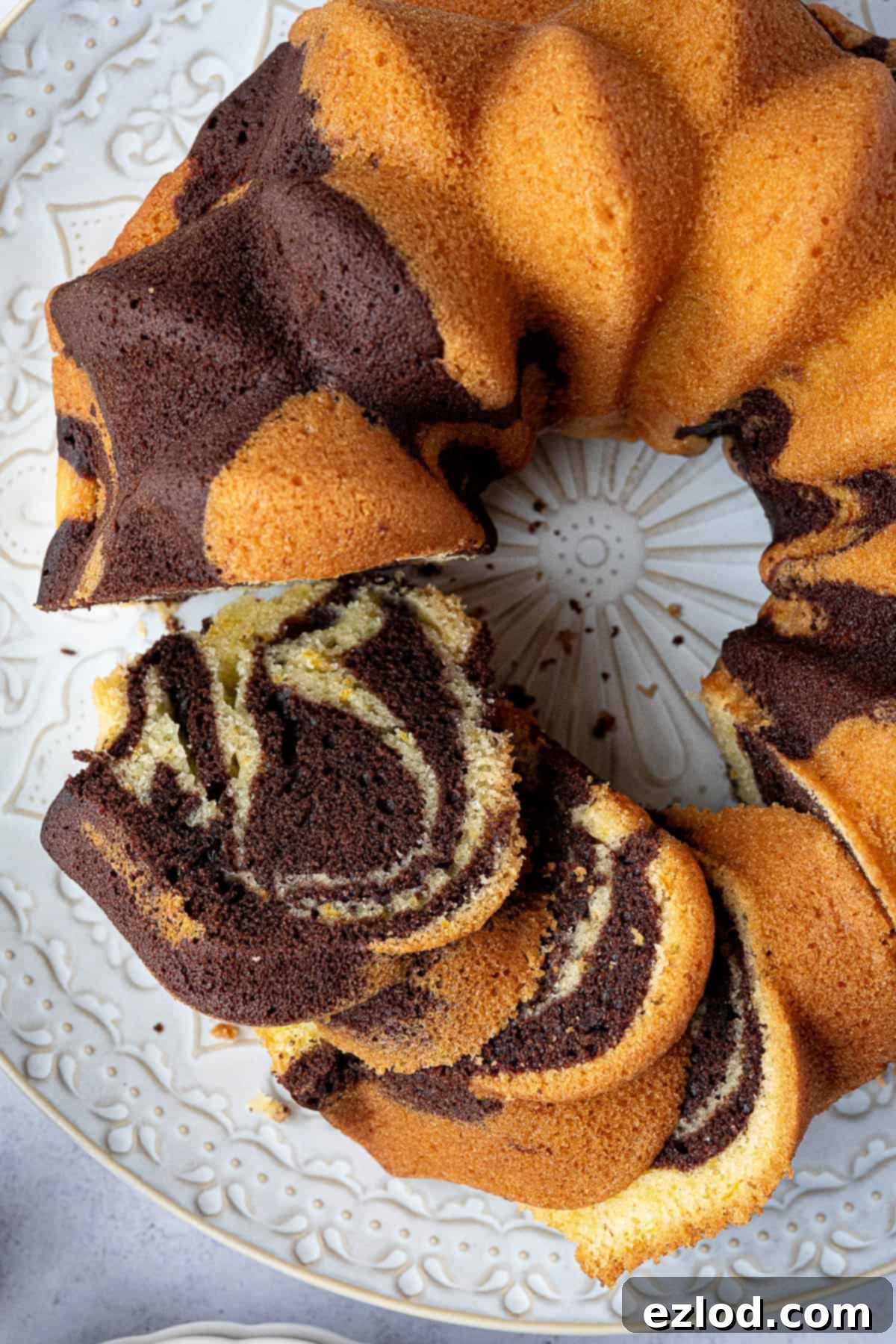
Top Tips for Baking the Perfect Vegan Bundt Cake:
Achieving a consistently perfect bundt cake is easier with these expert tips:
- Embrace Metric Measurements: For all my baking recipes, I wholeheartedly recommend using metric measurements with a digital scale rather than cup conversions. Cups are notoriously inaccurate and inconsistent, leading to varied results. A scale ensures precision, better consistency, and often, less mess!
- Avoid Over-Beating: Once you add the wet ingredients to the dry, mix only until the ingredients are just combined and no dry streaks remain. Over-beating develops the gluten in the flour, which can result in a tough, chewy cake rather than a tender, moist one.
- Know When It’s Done: Beyond the baking time, always rely on visual and tactile cues. The cake is ready when it springs back lightly when gently pressed and, most importantly, a skewer inserted into the deepest part of the cake comes out clean or with only a few moist crumbs, but no wet batter.
- Proper Storage: To keep your bundt cake fresh and delicious, store it in an airtight container at room temperature for up to 4-5 days. This helps maintain its moisture.
- Freezing for Later: This cake freezes beautifully! Once completely cooled, wrap it tightly in a double layer of plastic wrap, followed by a layer of aluminum foil, to prevent freezer burn. It can be frozen for up to 3 months. Thaw at room temperature before serving.
- Greasing Your Bundt Tin – A Non-Negotiable Step: I cannot stress this enough: take your time and be meticulous when greasing your bundt tin. Use a pastry brush or your fingers to ensure every curve, ridge, and intricate detail is coated with oil or vegan butter. A light dusting of flour or cocoa powder (for chocolate cakes) can also provide an extra layer of non-stick insurance. A well-greased tin is the secret to a perfect release.
- Patience During Cooling: Vegan cakes tend to be more delicate and prone to breaking when hot. Allowing the cake to cool in the tin for at least 20 minutes gives it crucial time to set and firm up before you attempt to invert it. This step is vital for preserving the cake’s beautiful shape.
- Room Temperature Ingredients: Whenever possible, ensure your liquid ingredients, like water or plant milk, are at room temperature. This helps them emulsify better with the oil and sugar, leading to a smoother batter and a more consistent cake texture.
- Tap the Tin: After pouring the batter into the bundt tin, gently tap the tin a few times on your counter. This helps to release any trapped air bubbles, ensuring a denser, more uniform crumb.
Delicious Variations and Creative Substitutions:
This chocolate orange bundt cake recipe is incredibly adaptable, allowing you to experiment with flavors and suit your preferences:
- Single-Flavored Delight: If you prefer a single-flavored cake, simply double the mixture for either the chocolate or the orange batter to create an entirely chocolate or an entirely orange bundt cake. Adjust the baking time if necessary.
- Classic Vanilla Bundt: Transform the orange batter into a classic vanilla version by omitting the orange zest, juice, and orange extract. Increase the water to 200ml and add 2 teaspoons of vanilla extract along with ½ teaspoon of vinegar (to provide the necessary acidity for rise).
- Coffee Infusion: For the chocolate batter, swap the water for freshly brewed, cooled strong coffee to create a mocha-flavored cake. Alternatively, for a subtle orange-chocolate twist, omit the vinegar and substitute half of the water with orange juice.
- Chocolate Chip Indulgence: Feel free to fold in a couple of handfuls of vegan chocolate chips (dark or semi-sweet) into either or both batters for an extra burst of chocolatey goodness.
- Zesty Lemon Bundt: Change the orange batter to a bright lemon flavor by replacing the orange zest with the zest of 2 large lemons. Omit the orange juice and instead use the juice of 1 lemon, topping it up with water as needed to reach 100ml. You can also add a teaspoon of lemon extract.
- Plant Milk Swap: For a slightly richer cake, the water in both batters can be swapped for unsweetened plant milk of your choice (e.g., almond, soy, oat milk). This will subtly alter the texture and flavor, adding a hint of creaminess.
- Alternative Baking Tins: Don’t have a bundt tin? No problem! This batter can be baked in a 23cm (9-inch) square tin, two 9-inch round cake pans, or even a large loaf pan. If using a square or round tin, the baking time will likely be shorter; start checking for doneness after 25-30 minutes.
- Simple Glaze or Ganache: For an extra touch of elegance and flavor, consider drizzling the cooled cake with a simple orange glaze (powdered sugar mixed with orange juice) or a rich vegan chocolate ganache.
- Spice it Up: Add a pinch of cinnamon, cardamom, or even a touch of ginger to the chocolate batter for a warm, spiced chocolate flavor.
More Delicious Vegan Bundt Cake Recipes to Explore:
If you loved this chocolate orange creation, be sure to try some of these other fantastic vegan bundt cake recipes:
- Vegan pumpkin bundt cake
- Vegan ginger bundt cake
- Vegan mango bundt cake
- Vegan mincemeat cake
- Vegan apple bundt cake
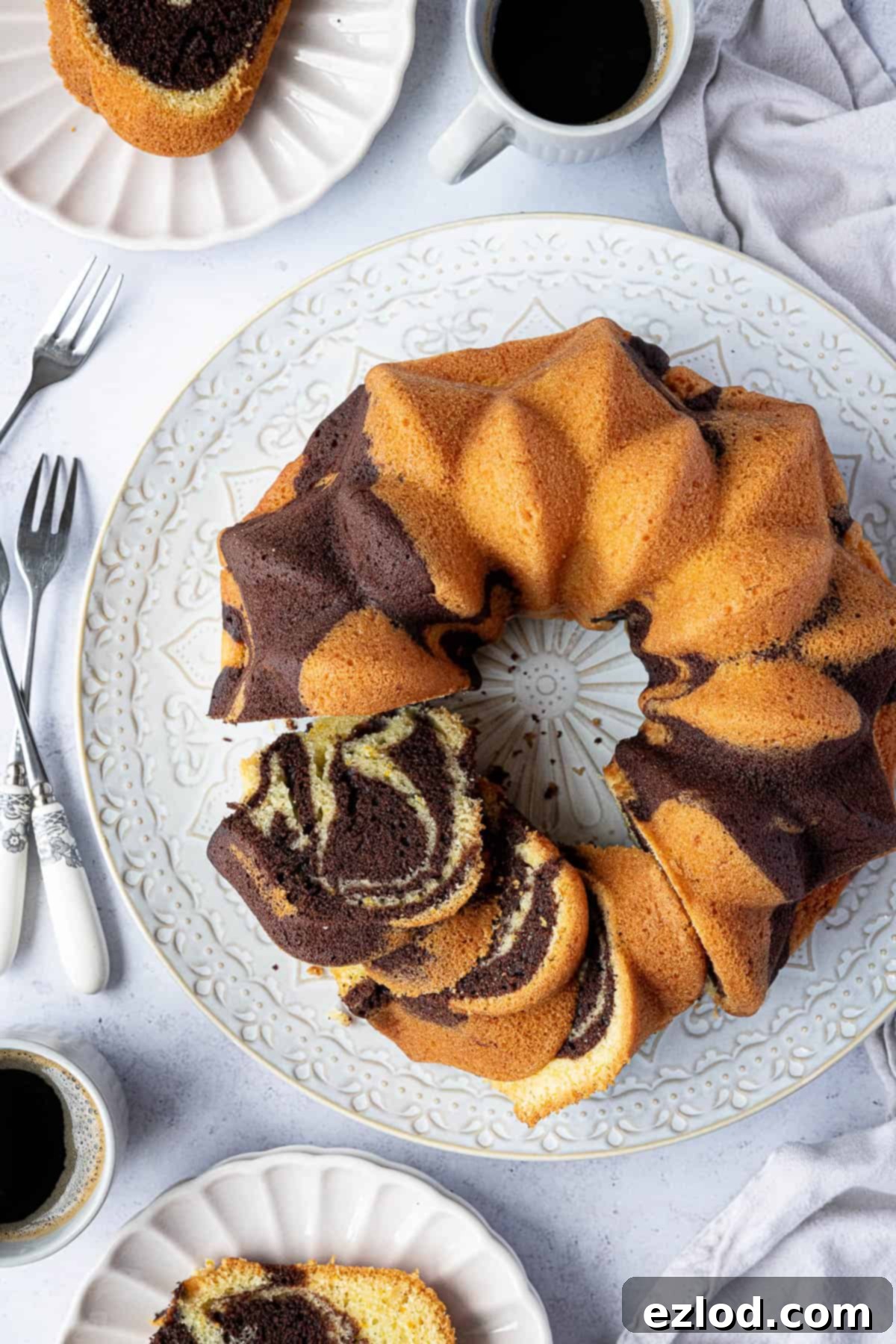
If you tried this recipe, I’d love to hear how it went! Please rate it, leave a comment below, or tag @domestic_gothess on Instagram and hashtag your creation #domesticgothess. Your feedback and photos are always appreciated!
All images and content on Domestic Gothess are copyright protected. If you wish to share this recipe, please do so by utilizing the provided share buttons. Do not screenshot or post the recipe or content in its entirety; instead, kindly include a direct link to this post for the complete recipe. Thank you for respecting our work.

Chocolate Orange Bundt Cake (Vegan)
Ingredients
Orange Batter:
- 200 g (1 + ⅔ cup) plain (all-purpose) flour
- 2 teaspoons baking powder
- 90 g (½ cup) caster or granulated sugar
- 50 ml (3 Tablespoons + 1 teaspoon) neutral oil
- finely grated zest of 1 large orange
- 100 ml (⅓ cup + 1 Tablespoon + 1 teaspoon) orange juice
- 100 ml (⅓ cup + 1 Tablespoon + 1 teaspoon) water
- 1 teaspoon orange extract optional
Chocolate Batter:
- 170 g (1 + scant ½ cup) plain (all-purpose) flour
- 30 g (⅓ cup) cocoa powder
- 2 teaspoons baking powder
- 90 g (½ cup) caster or granulated sugar
- 50 ml (3 Tablespoons + 1 teaspoon) neutral oil
- ½ teaspoon vinegar
- 200 ml (¾ cup + 4 teaspoons) water
- 1 teaspoon vanilla extract optional
Instructions
-
Preheat the oven to 180°C/160°C fan/350°F/gas mark 4. Grease a 10 cup bundt tin with oil or melted vegan butter making sure that you get right into all of the nooks and crannies.
-
Sift together the flour and baking powder for the orange batter in one bowl, and the flour, baking powder and cocoa powder for the chocolate batter in another.
-
Add the sugar, oil, orange zest and juice, water and orange extract to the orange batter, and the sugar, oil, vinegar, water and vanilla extract to the chocolate batter.
-
Stir each with a balloon whisk until no dry lumps remain.
-
Alternate spooning the batters into the bundt tin then gently run a knife though to swirl them together slightly.
-
Bake for 40-45 minutes until a skewer inserted into the centre comes out clean.
-
Allow to cool in the tin for 20 minutes then carefully turn it out onto a wire rack and leave to cool completely before serving.
Notes
- See post above for tips, details and step-by-step photos.
- As with all of my baking recipes I really do recommend using the metric measurements with a digital scale rather than the cup conversions. Cups are a wildly inaccurate measuring system and you will get far better, more consistent results using a scale, not to mention that it is also easier and less messy than cups!
